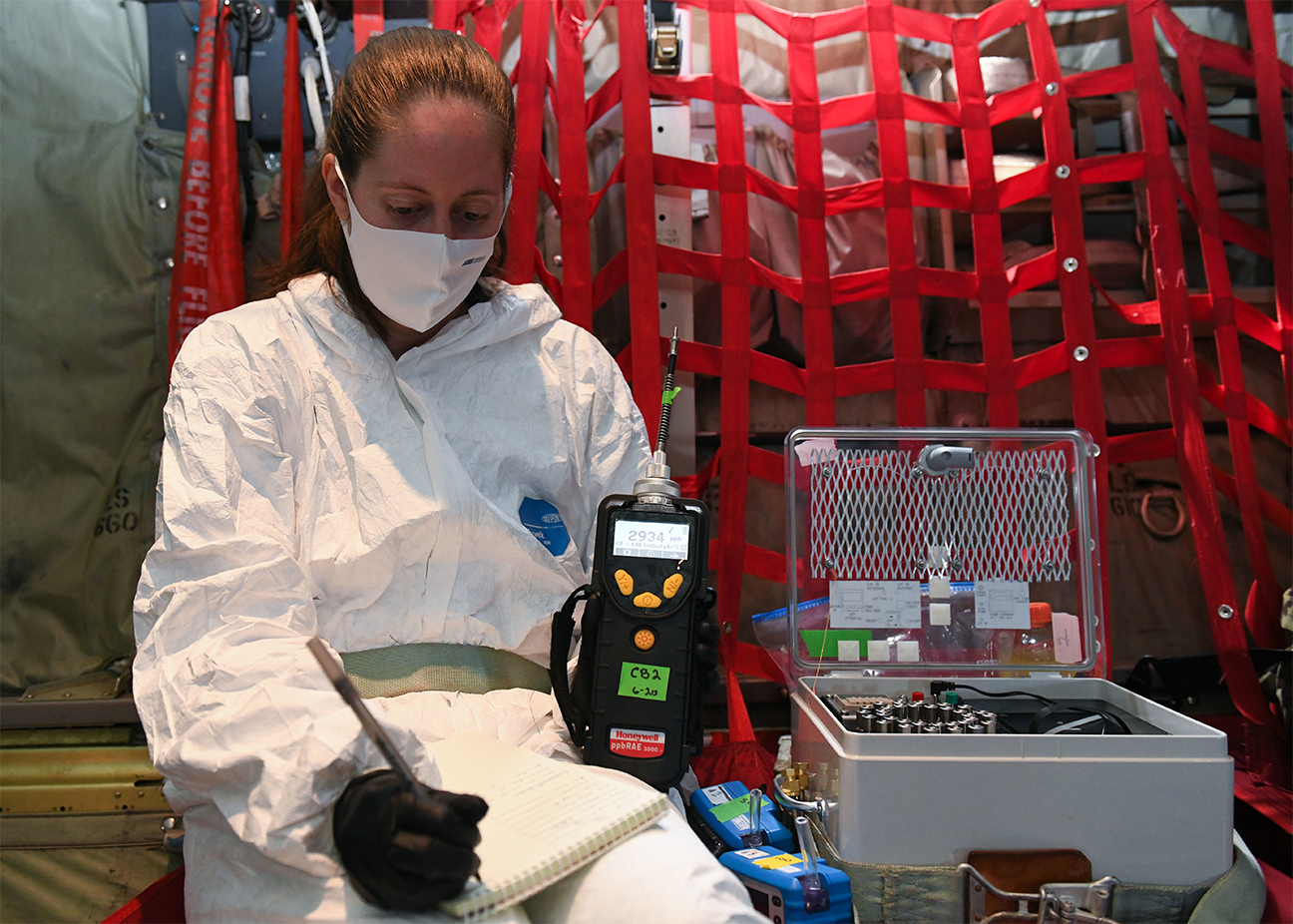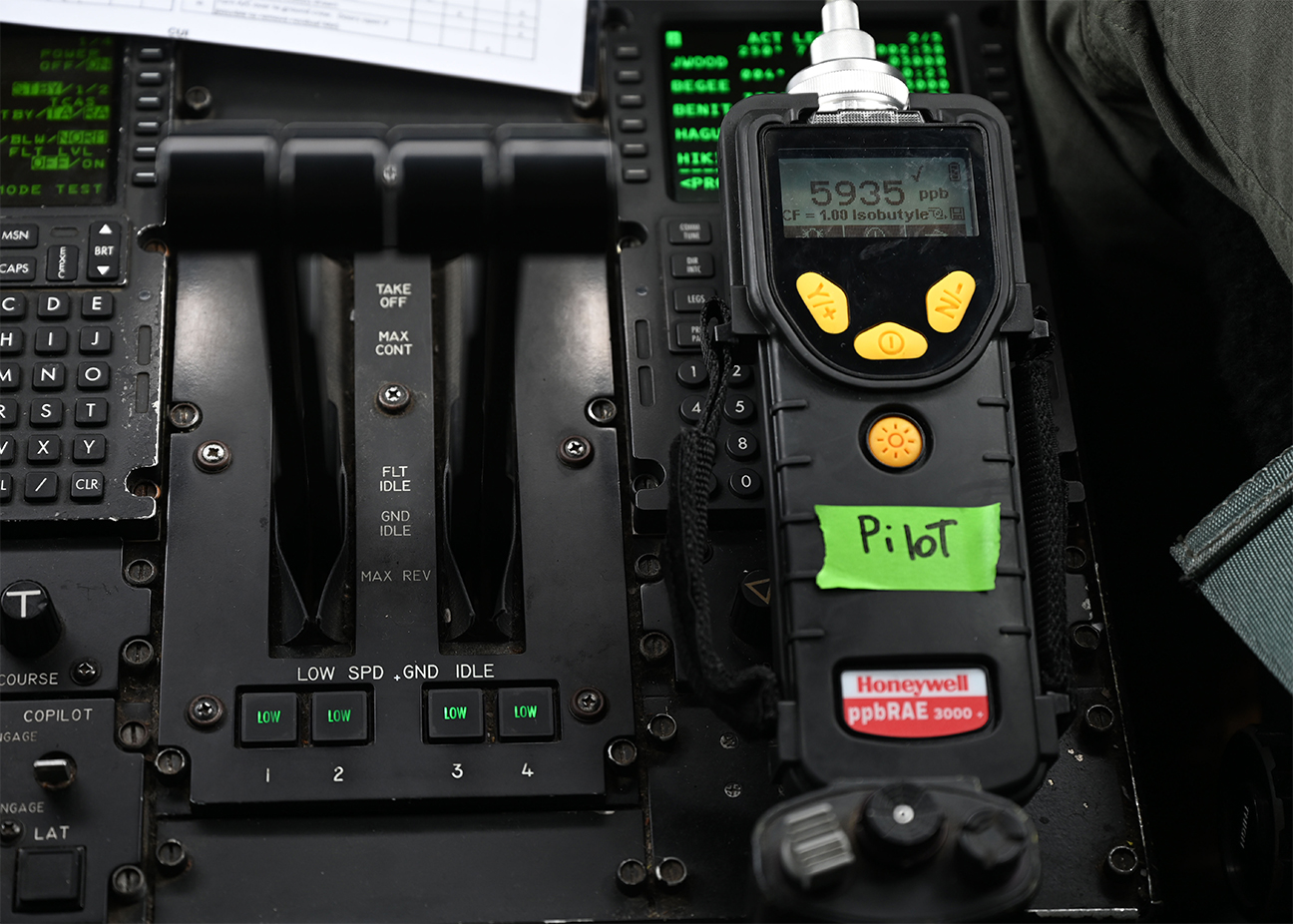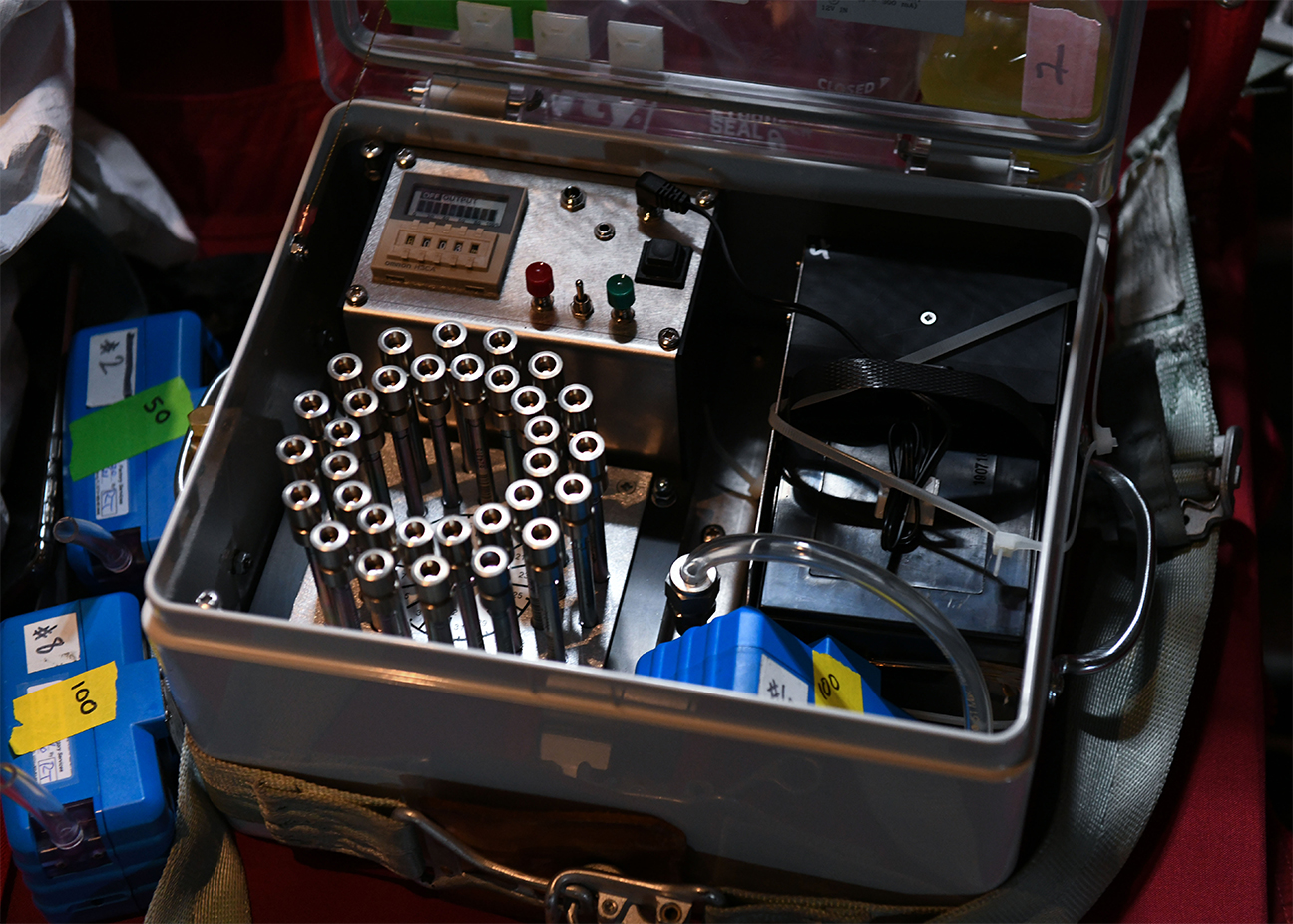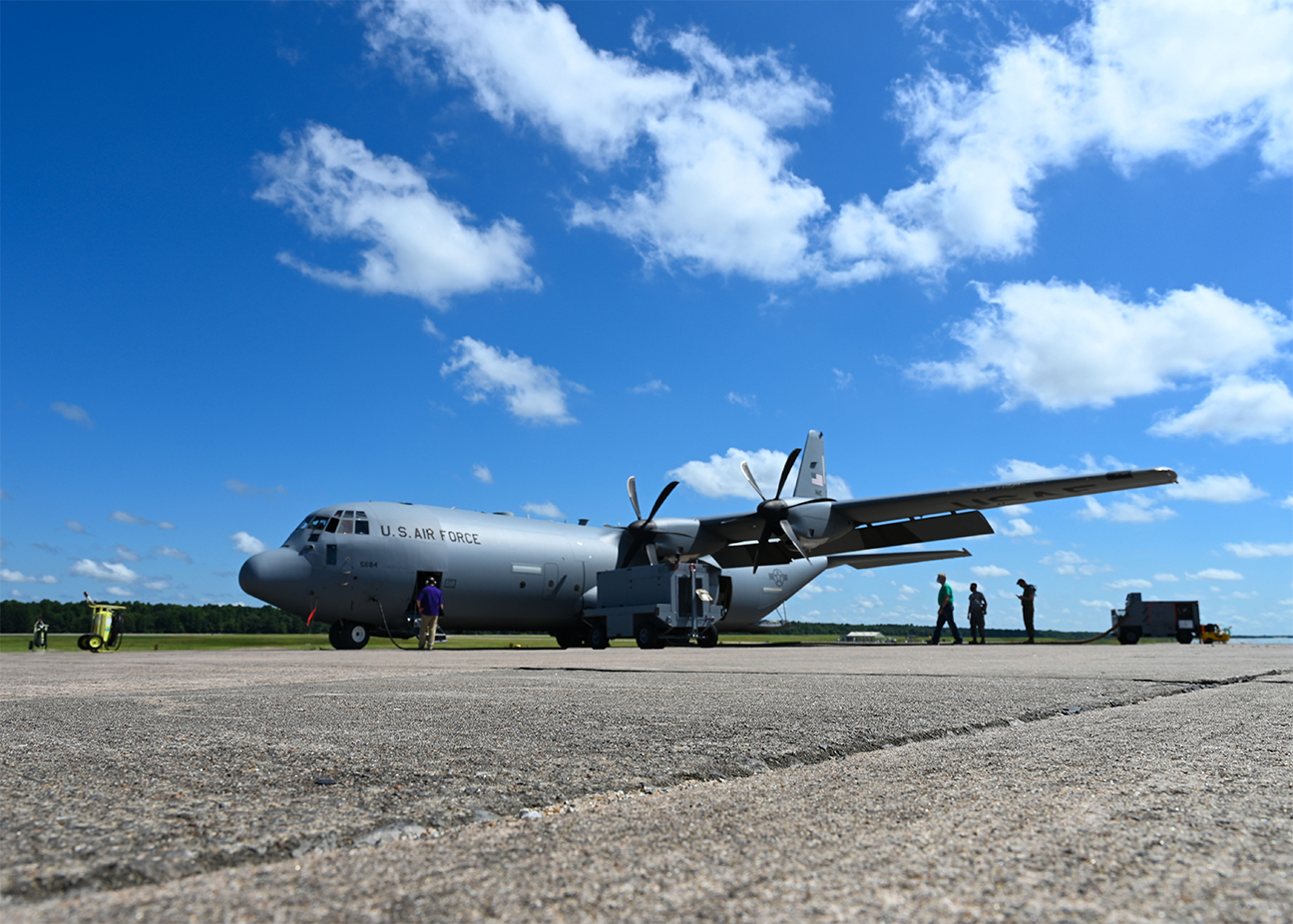Experiment enhances C-130’s competitive edge against CBRN threat
LITTLE ROCK AIR FORCE BASE, Ark. (AFNS) — Chemical, biological, radiological, and nuclear analysts from the 711th Human Performance Wing at Wright-Patterson Air Force Base, Ohio recently visited the 19th Airlift Wing to conduct the first vapor purge test on a cargo plane as part of a series of experiments they will conduct on aircraft across the Department of Defense.
The vapor purge tests look to determine how long it takes for a chemical contaminant, such as tear gas, to purge itself from an aircraft as well as potential best practices to reduce the amount of chemical particles in the air in the most efficient way possible.
Using a custom made pump, the analyst filled a C-130J Super Hercules with methyl salicylate, a common ingredient in mint candies, and used advanced measurement tools to monitor the concentration of the chemical in the air — effectively gauging how long it takes for the aircraft’s environmental control system to purge the contaminants.
“We’re introducing a chemical into the aircraft that’s a known stimulant for nerve agents and has been used on several other experiments across the DoD,” said Maj. Michael Horenziak, 711th Human Performance Wing research bioenvironmental engineer. “We try to simulate the plane coming in sometime after it comes in contact with a chemical. After filling the plane with the particles, we measure how long the ECS system takes to create a safe environment inside of the aircraft for anyone on board.”
The results of the experiments will allow analysts to then make recommendations on changes to aircrew equipment and uniforms in order to provide maximum comfortability to minimize fatigue while still maintaining the highest level of safety and effectiveness.
“We are looking to understand what’s going on inside an aircraft when a chemical weapon is involved or we try to fly an operation in a dirty environment,” said William Greer, 711th HPW senior CBRN analyst. “The information that we learn from this will be used by the people who develop the next generation of aircrew ensembles, providing equipment that allows Airmen to do their jobs more efficiently, more effectively and not suffer some of the encumbrances that come with the equipment we’re wearing now.”
The test, which was last completed in the 1970s and 1980s with equipment that would now be considered obsolete, gives the DoD up-to-date information on the way the chemical particles affect the aircraft and the crew onboard — potentially revolutionizing the way we fly across all branches.
“The numbers from this are being measured with equipment that’s generations ahead of the equipment that was used during the original tests,” Greer said. “There have been similar types of testing, but the approaches we’re using here, such as the equipment and the methods we employ, are giving us a much clearer picture of how the threat will affect aircrew both short- and long-term.”
Officials said the end-state objective for the vapor purge test is to improve the way aircrew across the DoD operate in chemically contaminated environments, providing the Defense Department a competitive advantage while maintaining operations around the globe.
“We hope that this test will give aircrews more flexibility with how they operate in an austere environment and allow them to fly more missions over time,” Greer said. “Long-term, we’re working with other groups to develop the next generation air fleet protection equipment. A few years down the road, we think that the results here will lead to the Air Force deploying new types of protective gear that would be more functional and allow the operator to maintain their competitive edge.”

A bioenvironmental analyst from the 711th Human Performance Wing at Wright-Patterson Air Force Base, Ohio, records data from a piece of equipment inside of a C-130J Super Hercules at Little Rock Air Force Base, Ark., July 24, 2020. Using a custom made pump, analysts from the 711th HPW filled a C-130J with methyl salicylate, a common ingredient in mint candies, and used advanced measurement tools to monitor the concentration of the chemical in the air — effectively gauging how long it takes for the aircraft’s environmental control system to purge the contaminants. (U.S. Air Force photo by Airman 1st Class Jayden Ford)

A piece of equipment reads the amount of chemical particles that are in the air inside of a C-130J Super Hercules at Little Rock Air Force Base, Ark., July 24, 2020. Chemical, biological, radiological, and nuclear analysts from the 711th Human Performance Wing at Wright-Patterson Air Force Base, Ohio, recently visited the 19th Airlift Wing to conduct the first vapor purge test on a cargo plane as part of a series of tests they have and will continue to conduct on aircraft across the Department of Defense. (U.S. Air Force photo by Airman 1st Class Jayden Ford)

A piece of equipment reads the amount of chemical particles that are in the air inside a C-130J Super Hercules at Little Rock Air Force Base, Ark., July 24, 2020. Chemical, biological, radiological, and nuclear analysts from the 711th Human Performance Wing at Wright-Patterson Air Force Base, Ohio, conducted an experiment that looked to determine how long it takes for a chemical contaminant, such as tear gas, to purge itself from an aircraft as well as potential best practices to reduce the amount of chemical particles in the air in the most efficient way possible. (U.S. Air Force photo by Airman 1st Class Jayden Ford)

A C-130J Super Hercules sits on the flightline as it is prepared for a vapor purge experiment at Little Rock Air Force Base, Ark., July 24, 2020. Chemical, biological, radiological, and nuclear analysts from the 711th Human Performance Wing at Wright-Patterson Air Force Base, Ohio, conducted an experiment that looked to determine how long it takes for a chemical contaminant, such as tear gas, to purge itself from an aircraft as well as potential best practices to reduce the amount of chemical particles in the air in the most efficient way possible. (U.S. Air Force photo by Airman 1st Class Jayden Ford)
